Management and Operations Report: Theories and Approaches Analysis
VerifiedAdded on 2020/09/17
|16
|4818
|340
Report
AI Summary
This report delves into the intricacies of management and operations, analyzing the distinct roles and characteristics of leaders and managers within an organizational context, using Marks and Spencer as a case study. It explores various leadership theories, including situational, trait, path-goal, transactional, and transformational theories, and their application in different organizational scenarios. The report further examines the role of leaders and managers in addressing challenges like conflicts, human resource management, and globalization. It also investigates key approaches to operational management, emphasizing the importance of operational efficiency and decision-making factors. The report provides a comprehensive overview of how leadership and management impact business objectives and the wider community.
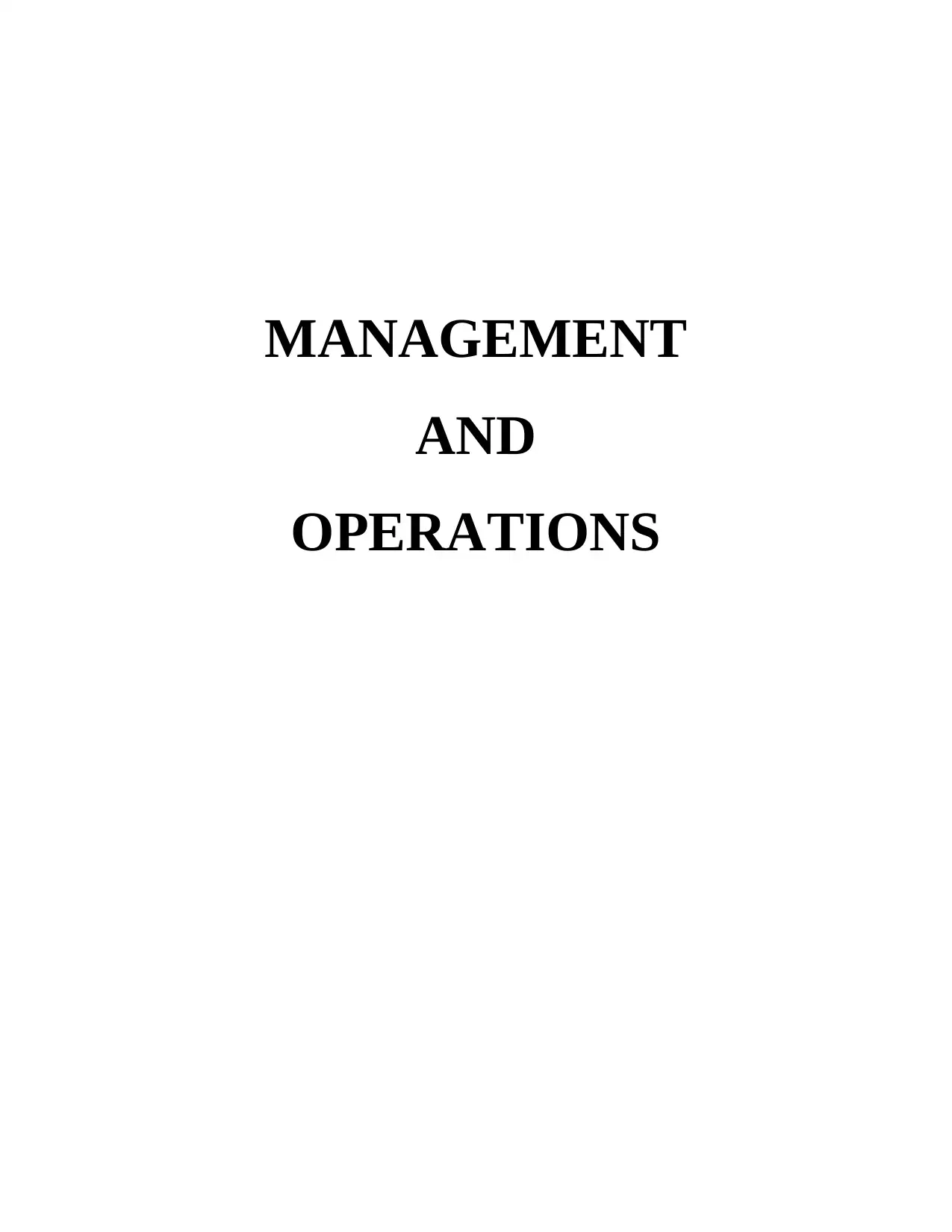
MANAGEMENT
AND
OPERATIONS
AND
OPERATIONS
Paraphrase This Document
Need a fresh take? Get an instant paraphrase of this document with our AI Paraphraser
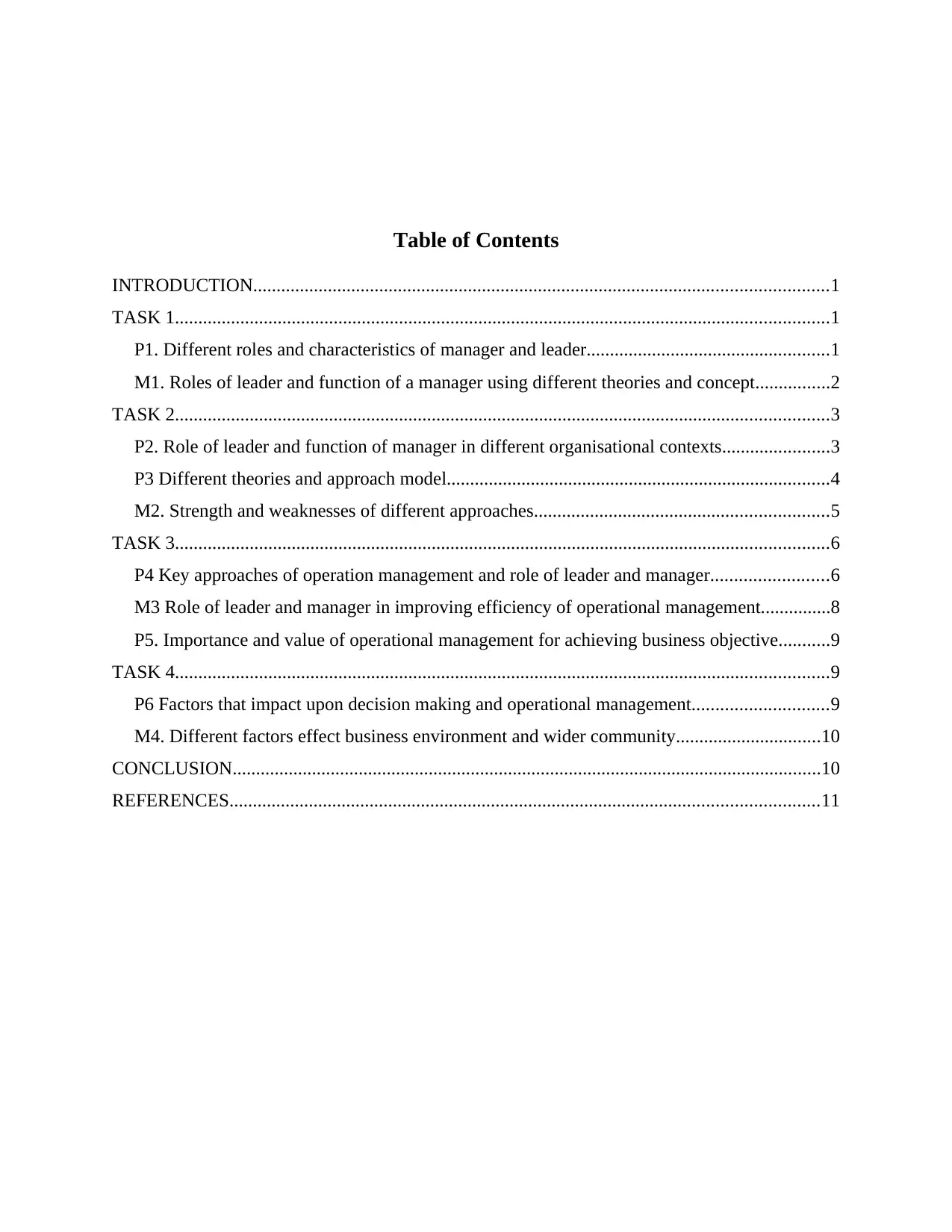
Table of Contents
INTRODUCTION...........................................................................................................................1
TASK 1............................................................................................................................................1
P1. Different roles and characteristics of manager and leader....................................................1
M1. Roles of leader and function of a manager using different theories and concept................2
TASK 2............................................................................................................................................3
P2. Role of leader and function of manager in different organisational contexts.......................3
P3 Different theories and approach model..................................................................................4
M2. Strength and weaknesses of different approaches...............................................................5
TASK 3............................................................................................................................................6
P4 Key approaches of operation management and role of leader and manager.........................6
M3 Role of leader and manager in improving efficiency of operational management...............8
P5. Importance and value of operational management for achieving business objective...........9
TASK 4............................................................................................................................................9
P6 Factors that impact upon decision making and operational management.............................9
M4. Different factors effect business environment and wider community...............................10
CONCLUSION..............................................................................................................................10
REFERENCES..............................................................................................................................11
INTRODUCTION...........................................................................................................................1
TASK 1............................................................................................................................................1
P1. Different roles and characteristics of manager and leader....................................................1
M1. Roles of leader and function of a manager using different theories and concept................2
TASK 2............................................................................................................................................3
P2. Role of leader and function of manager in different organisational contexts.......................3
P3 Different theories and approach model..................................................................................4
M2. Strength and weaknesses of different approaches...............................................................5
TASK 3............................................................................................................................................6
P4 Key approaches of operation management and role of leader and manager.........................6
M3 Role of leader and manager in improving efficiency of operational management...............8
P5. Importance and value of operational management for achieving business objective...........9
TASK 4............................................................................................................................................9
P6 Factors that impact upon decision making and operational management.............................9
M4. Different factors effect business environment and wider community...............................10
CONCLUSION..............................................................................................................................10
REFERENCES..............................................................................................................................11

⊘ This is a preview!⊘
Do you want full access?
Subscribe today to unlock all pages.

Trusted by 1+ million students worldwide
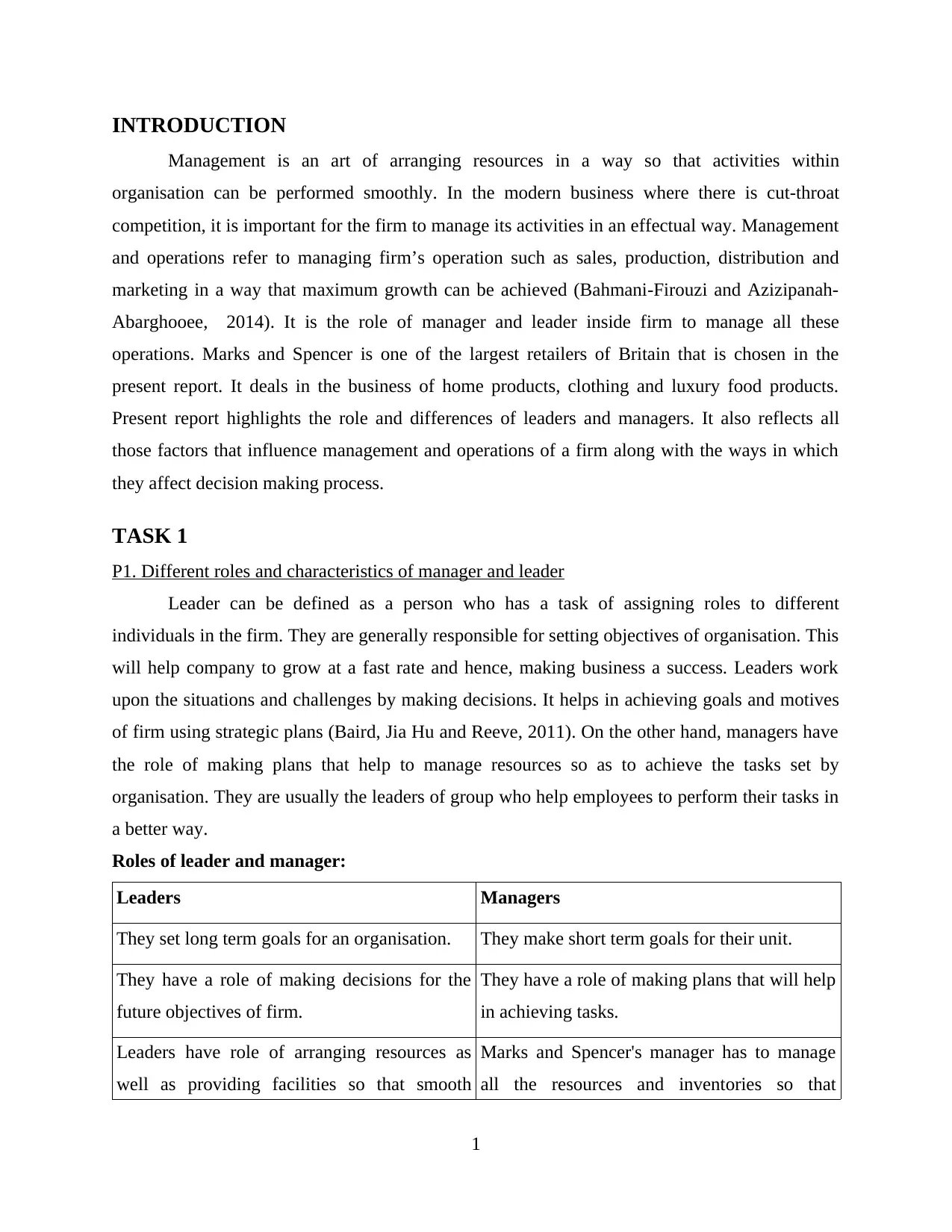
INTRODUCTION
Management is an art of arranging resources in a way so that activities within
organisation can be performed smoothly. In the modern business where there is cut-throat
competition, it is important for the firm to manage its activities in an effectual way. Management
and operations refer to managing firm’s operation such as sales, production, distribution and
marketing in a way that maximum growth can be achieved (Bahmani-Firouzi and Azizipanah-
Abarghooee, 2014). It is the role of manager and leader inside firm to manage all these
operations. Marks and Spencer is one of the largest retailers of Britain that is chosen in the
present report. It deals in the business of home products, clothing and luxury food products.
Present report highlights the role and differences of leaders and managers. It also reflects all
those factors that influence management and operations of a firm along with the ways in which
they affect decision making process.
TASK 1
P1. Different roles and characteristics of manager and leader
Leader can be defined as a person who has a task of assigning roles to different
individuals in the firm. They are generally responsible for setting objectives of organisation. This
will help company to grow at a fast rate and hence, making business a success. Leaders work
upon the situations and challenges by making decisions. It helps in achieving goals and motives
of firm using strategic plans (Baird, Jia Hu and Reeve, 2011). On the other hand, managers have
the role of making plans that help to manage resources so as to achieve the tasks set by
organisation. They are usually the leaders of group who help employees to perform their tasks in
a better way.
Roles of leader and manager:
Leaders Managers
They set long term goals for an organisation. They make short term goals for their unit.
They have a role of making decisions for the
future objectives of firm.
They have a role of making plans that will help
in achieving tasks.
Leaders have role of arranging resources as
well as providing facilities so that smooth
Marks and Spencer's manager has to manage
all the resources and inventories so that
1
Management is an art of arranging resources in a way so that activities within
organisation can be performed smoothly. In the modern business where there is cut-throat
competition, it is important for the firm to manage its activities in an effectual way. Management
and operations refer to managing firm’s operation such as sales, production, distribution and
marketing in a way that maximum growth can be achieved (Bahmani-Firouzi and Azizipanah-
Abarghooee, 2014). It is the role of manager and leader inside firm to manage all these
operations. Marks and Spencer is one of the largest retailers of Britain that is chosen in the
present report. It deals in the business of home products, clothing and luxury food products.
Present report highlights the role and differences of leaders and managers. It also reflects all
those factors that influence management and operations of a firm along with the ways in which
they affect decision making process.
TASK 1
P1. Different roles and characteristics of manager and leader
Leader can be defined as a person who has a task of assigning roles to different
individuals in the firm. They are generally responsible for setting objectives of organisation. This
will help company to grow at a fast rate and hence, making business a success. Leaders work
upon the situations and challenges by making decisions. It helps in achieving goals and motives
of firm using strategic plans (Baird, Jia Hu and Reeve, 2011). On the other hand, managers have
the role of making plans that help to manage resources so as to achieve the tasks set by
organisation. They are usually the leaders of group who help employees to perform their tasks in
a better way.
Roles of leader and manager:
Leaders Managers
They set long term goals for an organisation. They make short term goals for their unit.
They have a role of making decisions for the
future objectives of firm.
They have a role of making plans that will help
in achieving tasks.
Leaders have role of arranging resources as
well as providing facilities so that smooth
Marks and Spencer's manager has to manage
all the resources and inventories so that
1
Paraphrase This Document
Need a fresh take? Get an instant paraphrase of this document with our AI Paraphraser
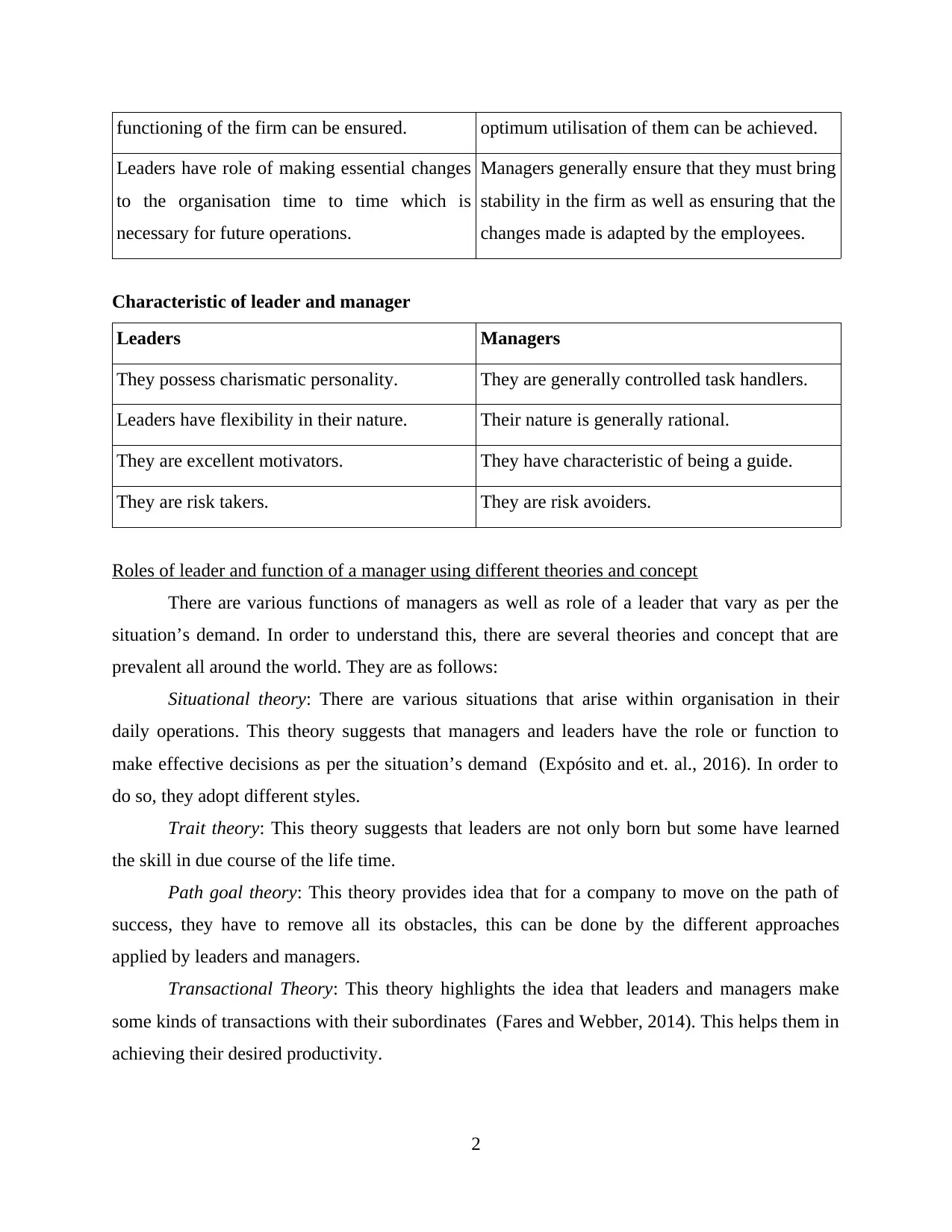
functioning of the firm can be ensured. optimum utilisation of them can be achieved.
Leaders have role of making essential changes
to the organisation time to time which is
necessary for future operations.
Managers generally ensure that they must bring
stability in the firm as well as ensuring that the
changes made is adapted by the employees.
Characteristic of leader and manager
Leaders Managers
They possess charismatic personality. They are generally controlled task handlers.
Leaders have flexibility in their nature. Their nature is generally rational.
They are excellent motivators. They have characteristic of being a guide.
They are risk takers. They are risk avoiders.
Roles of leader and function of a manager using different theories and concept
There are various functions of managers as well as role of a leader that vary as per the
situation’s demand. In order to understand this, there are several theories and concept that are
prevalent all around the world. They are as follows:
Situational theory: There are various situations that arise within organisation in their
daily operations. This theory suggests that managers and leaders have the role or function to
make effective decisions as per the situation’s demand (Expósito and et. al., 2016). In order to
do so, they adopt different styles.
Trait theory: This theory suggests that leaders are not only born but some have learned
the skill in due course of the life time.
Path goal theory: This theory provides idea that for a company to move on the path of
success, they have to remove all its obstacles, this can be done by the different approaches
applied by leaders and managers.
Transactional Theory: This theory highlights the idea that leaders and managers make
some kinds of transactions with their subordinates (Fares and Webber, 2014). This helps them in
achieving their desired productivity.
2
Leaders have role of making essential changes
to the organisation time to time which is
necessary for future operations.
Managers generally ensure that they must bring
stability in the firm as well as ensuring that the
changes made is adapted by the employees.
Characteristic of leader and manager
Leaders Managers
They possess charismatic personality. They are generally controlled task handlers.
Leaders have flexibility in their nature. Their nature is generally rational.
They are excellent motivators. They have characteristic of being a guide.
They are risk takers. They are risk avoiders.
Roles of leader and function of a manager using different theories and concept
There are various functions of managers as well as role of a leader that vary as per the
situation’s demand. In order to understand this, there are several theories and concept that are
prevalent all around the world. They are as follows:
Situational theory: There are various situations that arise within organisation in their
daily operations. This theory suggests that managers and leaders have the role or function to
make effective decisions as per the situation’s demand (Expósito and et. al., 2016). In order to
do so, they adopt different styles.
Trait theory: This theory suggests that leaders are not only born but some have learned
the skill in due course of the life time.
Path goal theory: This theory provides idea that for a company to move on the path of
success, they have to remove all its obstacles, this can be done by the different approaches
applied by leaders and managers.
Transactional Theory: This theory highlights the idea that leaders and managers make
some kinds of transactions with their subordinates (Fares and Webber, 2014). This helps them in
achieving their desired productivity.
2
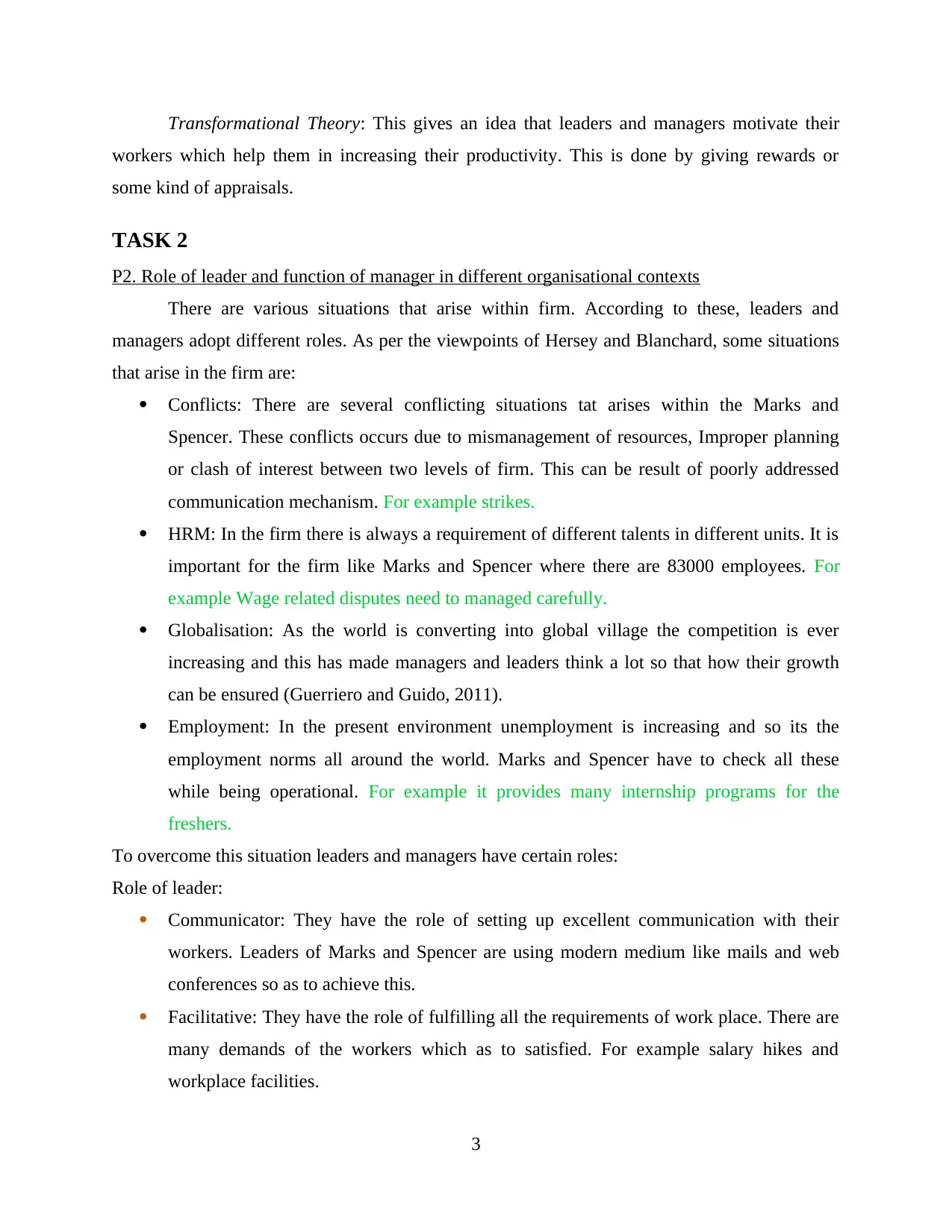
Transformational Theory: This gives an idea that leaders and managers motivate their
workers which help them in increasing their productivity. This is done by giving rewards or
some kind of appraisals.
TASK 2
P2. Role of leader and function of manager in different organisational contexts
There are various situations that arise within firm. According to these, leaders and
managers adopt different roles. As per the viewpoints of Hersey and Blanchard, some situations
that arise in the firm are:
Conflicts: There are several conflicting situations tat arises within the Marks and
Spencer. These conflicts occurs due to mismanagement of resources, Improper planning
or clash of interest between two levels of firm. This can be result of poorly addressed
communication mechanism. For example strikes.
HRM: In the firm there is always a requirement of different talents in different units. It is
important for the firm like Marks and Spencer where there are 83000 employees. For
example Wage related disputes need to managed carefully.
Globalisation: As the world is converting into global village the competition is ever
increasing and this has made managers and leaders think a lot so that how their growth
can be ensured (Guerriero and Guido, 2011).
Employment: In the present environment unemployment is increasing and so its the
employment norms all around the world. Marks and Spencer have to check all these
while being operational. For example it provides many internship programs for the
freshers.
To overcome this situation leaders and managers have certain roles:
Role of leader:
Communicator: They have the role of setting up excellent communication with their
workers. Leaders of Marks and Spencer are using modern medium like mails and web
conferences so as to achieve this.
Facilitative: They have the role of fulfilling all the requirements of work place. There are
many demands of the workers which as to satisfied. For example salary hikes and
workplace facilities.
3
workers which help them in increasing their productivity. This is done by giving rewards or
some kind of appraisals.
TASK 2
P2. Role of leader and function of manager in different organisational contexts
There are various situations that arise within firm. According to these, leaders and
managers adopt different roles. As per the viewpoints of Hersey and Blanchard, some situations
that arise in the firm are:
Conflicts: There are several conflicting situations tat arises within the Marks and
Spencer. These conflicts occurs due to mismanagement of resources, Improper planning
or clash of interest between two levels of firm. This can be result of poorly addressed
communication mechanism. For example strikes.
HRM: In the firm there is always a requirement of different talents in different units. It is
important for the firm like Marks and Spencer where there are 83000 employees. For
example Wage related disputes need to managed carefully.
Globalisation: As the world is converting into global village the competition is ever
increasing and this has made managers and leaders think a lot so that how their growth
can be ensured (Guerriero and Guido, 2011).
Employment: In the present environment unemployment is increasing and so its the
employment norms all around the world. Marks and Spencer have to check all these
while being operational. For example it provides many internship programs for the
freshers.
To overcome this situation leaders and managers have certain roles:
Role of leader:
Communicator: They have the role of setting up excellent communication with their
workers. Leaders of Marks and Spencer are using modern medium like mails and web
conferences so as to achieve this.
Facilitative: They have the role of fulfilling all the requirements of work place. There are
many demands of the workers which as to satisfied. For example salary hikes and
workplace facilities.
3
⊘ This is a preview!⊘
Do you want full access?
Subscribe today to unlock all pages.

Trusted by 1+ million students worldwide
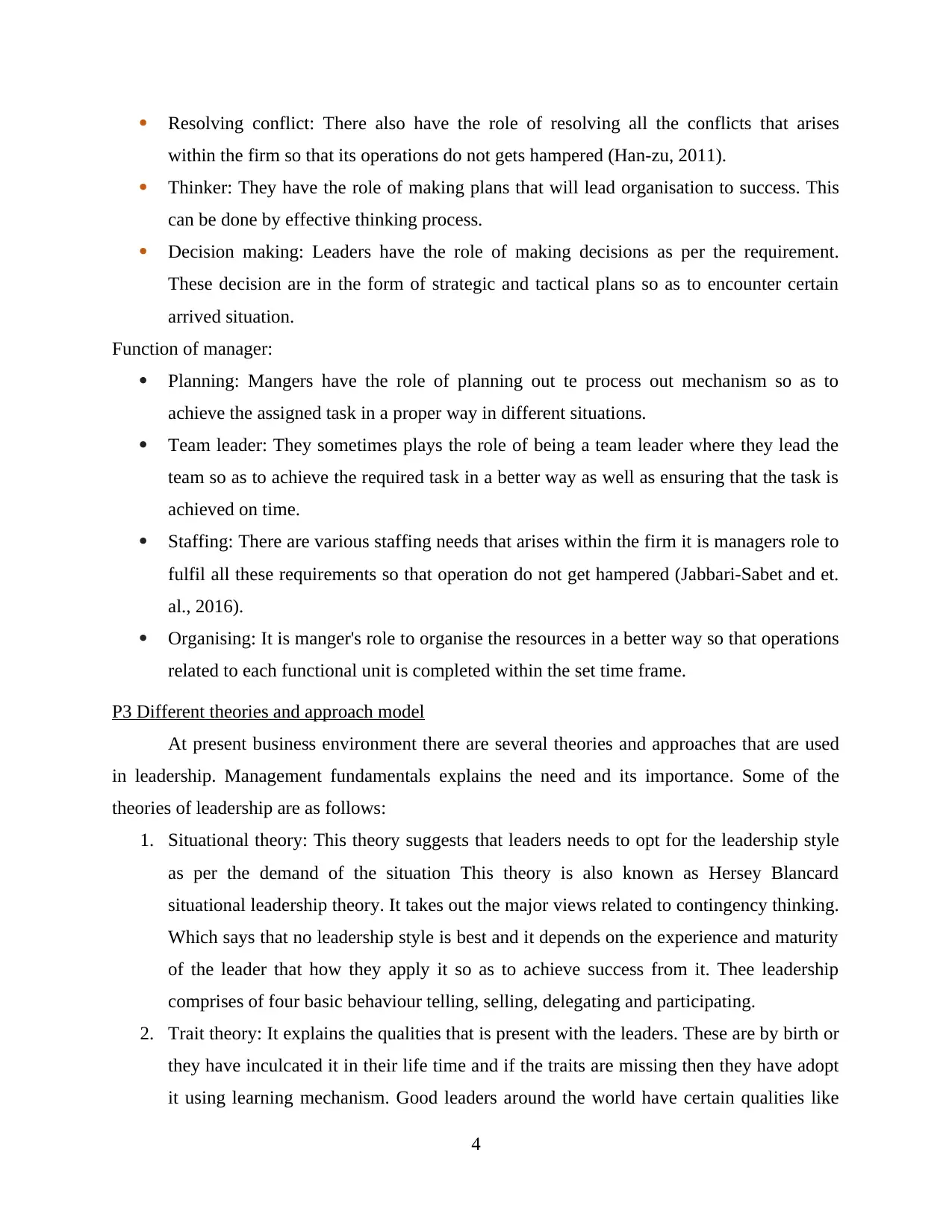
Resolving conflict: There also have the role of resolving all the conflicts that arises
within the firm so that its operations do not gets hampered (Han-zu, 2011).
Thinker: They have the role of making plans that will lead organisation to success. This
can be done by effective thinking process.
Decision making: Leaders have the role of making decisions as per the requirement.
These decision are in the form of strategic and tactical plans so as to encounter certain
arrived situation.
Function of manager:
Planning: Mangers have the role of planning out te process out mechanism so as to
achieve the assigned task in a proper way in different situations.
Team leader: They sometimes plays the role of being a team leader where they lead the
team so as to achieve the required task in a better way as well as ensuring that the task is
achieved on time.
Staffing: There are various staffing needs that arises within the firm it is managers role to
fulfil all these requirements so that operation do not get hampered (Jabbari-Sabet and et.
al., 2016).
Organising: It is manger's role to organise the resources in a better way so that operations
related to each functional unit is completed within the set time frame.
P3 Different theories and approach model
At present business environment there are several theories and approaches that are used
in leadership. Management fundamentals explains the need and its importance. Some of the
theories of leadership are as follows:
1. Situational theory: This theory suggests that leaders needs to opt for the leadership style
as per the demand of the situation This theory is also known as Hersey Blancard
situational leadership theory. It takes out the major views related to contingency thinking.
Which says that no leadership style is best and it depends on the experience and maturity
of the leader that how they apply it so as to achieve success from it. Thee leadership
comprises of four basic behaviour telling, selling, delegating and participating.
2. Trait theory: It explains the qualities that is present with the leaders. These are by birth or
they have inculcated it in their life time and if the traits are missing then they have adopt
it using learning mechanism. Good leaders around the world have certain qualities like
4
within the firm so that its operations do not gets hampered (Han-zu, 2011).
Thinker: They have the role of making plans that will lead organisation to success. This
can be done by effective thinking process.
Decision making: Leaders have the role of making decisions as per the requirement.
These decision are in the form of strategic and tactical plans so as to encounter certain
arrived situation.
Function of manager:
Planning: Mangers have the role of planning out te process out mechanism so as to
achieve the assigned task in a proper way in different situations.
Team leader: They sometimes plays the role of being a team leader where they lead the
team so as to achieve the required task in a better way as well as ensuring that the task is
achieved on time.
Staffing: There are various staffing needs that arises within the firm it is managers role to
fulfil all these requirements so that operation do not get hampered (Jabbari-Sabet and et.
al., 2016).
Organising: It is manger's role to organise the resources in a better way so that operations
related to each functional unit is completed within the set time frame.
P3 Different theories and approach model
At present business environment there are several theories and approaches that are used
in leadership. Management fundamentals explains the need and its importance. Some of the
theories of leadership are as follows:
1. Situational theory: This theory suggests that leaders needs to opt for the leadership style
as per the demand of the situation This theory is also known as Hersey Blancard
situational leadership theory. It takes out the major views related to contingency thinking.
Which says that no leadership style is best and it depends on the experience and maturity
of the leader that how they apply it so as to achieve success from it. Thee leadership
comprises of four basic behaviour telling, selling, delegating and participating.
2. Trait theory: It explains the qualities that is present with the leaders. These are by birth or
they have inculcated it in their life time and if the traits are missing then they have adopt
it using learning mechanism. Good leaders around the world have certain qualities like
4
Paraphrase This Document
Need a fresh take? Get an instant paraphrase of this document with our AI Paraphraser
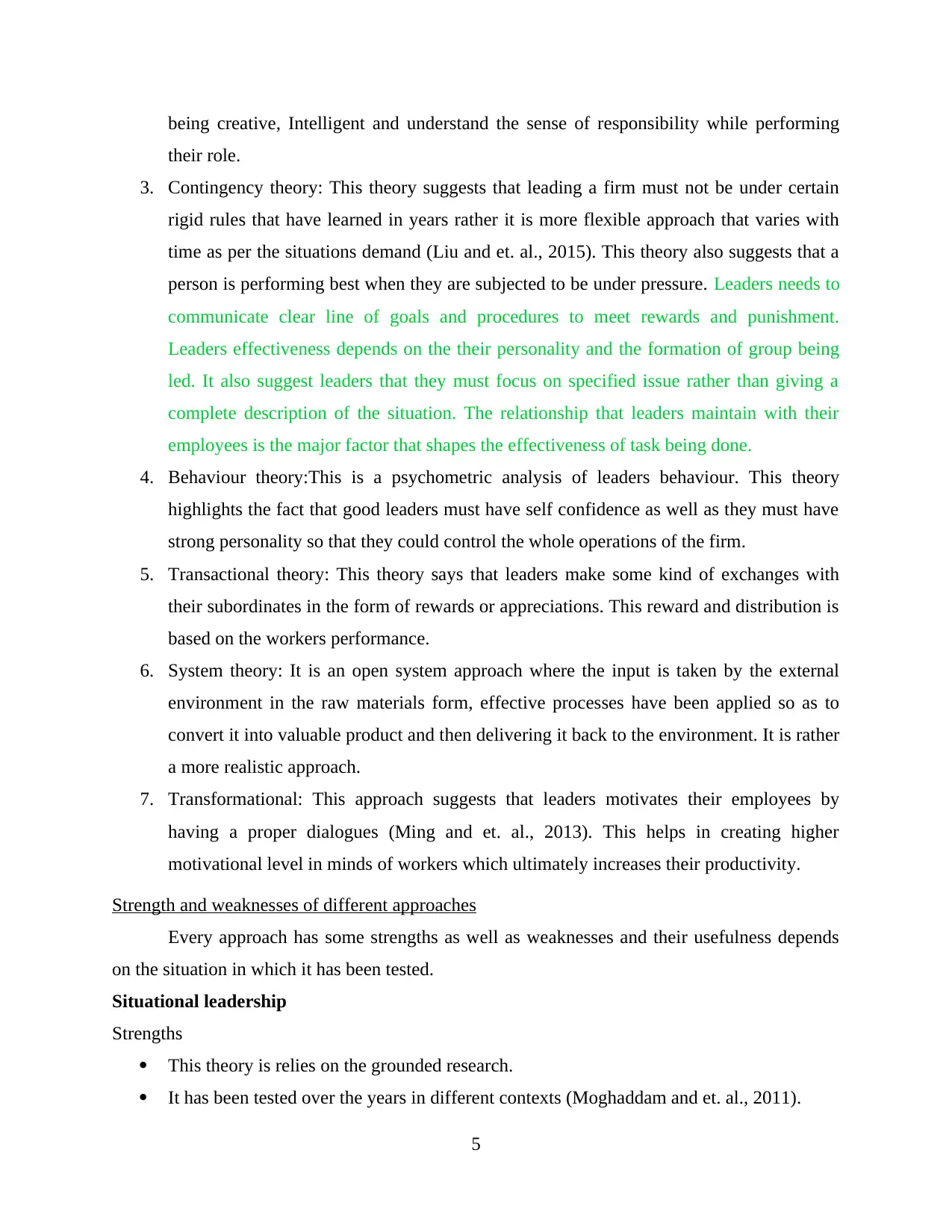
being creative, Intelligent and understand the sense of responsibility while performing
their role.
3. Contingency theory: This theory suggests that leading a firm must not be under certain
rigid rules that have learned in years rather it is more flexible approach that varies with
time as per the situations demand (Liu and et. al., 2015). This theory also suggests that a
person is performing best when they are subjected to be under pressure. Leaders needs to
communicate clear line of goals and procedures to meet rewards and punishment.
Leaders effectiveness depends on the their personality and the formation of group being
led. It also suggest leaders that they must focus on specified issue rather than giving a
complete description of the situation. The relationship that leaders maintain with their
employees is the major factor that shapes the effectiveness of task being done.
4. Behaviour theory:This is a psychometric analysis of leaders behaviour. This theory
highlights the fact that good leaders must have self confidence as well as they must have
strong personality so that they could control the whole operations of the firm.
5. Transactional theory: This theory says that leaders make some kind of exchanges with
their subordinates in the form of rewards or appreciations. This reward and distribution is
based on the workers performance.
6. System theory: It is an open system approach where the input is taken by the external
environment in the raw materials form, effective processes have been applied so as to
convert it into valuable product and then delivering it back to the environment. It is rather
a more realistic approach.
7. Transformational: This approach suggests that leaders motivates their employees by
having a proper dialogues (Ming and et. al., 2013). This helps in creating higher
motivational level in minds of workers which ultimately increases their productivity.
Strength and weaknesses of different approaches
Every approach has some strengths as well as weaknesses and their usefulness depends
on the situation in which it has been tested.
Situational leadership
Strengths
This theory is relies on the grounded research.
It has been tested over the years in different contexts (Moghaddam and et. al., 2011).
5
their role.
3. Contingency theory: This theory suggests that leading a firm must not be under certain
rigid rules that have learned in years rather it is more flexible approach that varies with
time as per the situations demand (Liu and et. al., 2015). This theory also suggests that a
person is performing best when they are subjected to be under pressure. Leaders needs to
communicate clear line of goals and procedures to meet rewards and punishment.
Leaders effectiveness depends on the their personality and the formation of group being
led. It also suggest leaders that they must focus on specified issue rather than giving a
complete description of the situation. The relationship that leaders maintain with their
employees is the major factor that shapes the effectiveness of task being done.
4. Behaviour theory:This is a psychometric analysis of leaders behaviour. This theory
highlights the fact that good leaders must have self confidence as well as they must have
strong personality so that they could control the whole operations of the firm.
5. Transactional theory: This theory says that leaders make some kind of exchanges with
their subordinates in the form of rewards or appreciations. This reward and distribution is
based on the workers performance.
6. System theory: It is an open system approach where the input is taken by the external
environment in the raw materials form, effective processes have been applied so as to
convert it into valuable product and then delivering it back to the environment. It is rather
a more realistic approach.
7. Transformational: This approach suggests that leaders motivates their employees by
having a proper dialogues (Ming and et. al., 2013). This helps in creating higher
motivational level in minds of workers which ultimately increases their productivity.
Strength and weaknesses of different approaches
Every approach has some strengths as well as weaknesses and their usefulness depends
on the situation in which it has been tested.
Situational leadership
Strengths
This theory is relies on the grounded research.
It has been tested over the years in different contexts (Moghaddam and et. al., 2011).
5
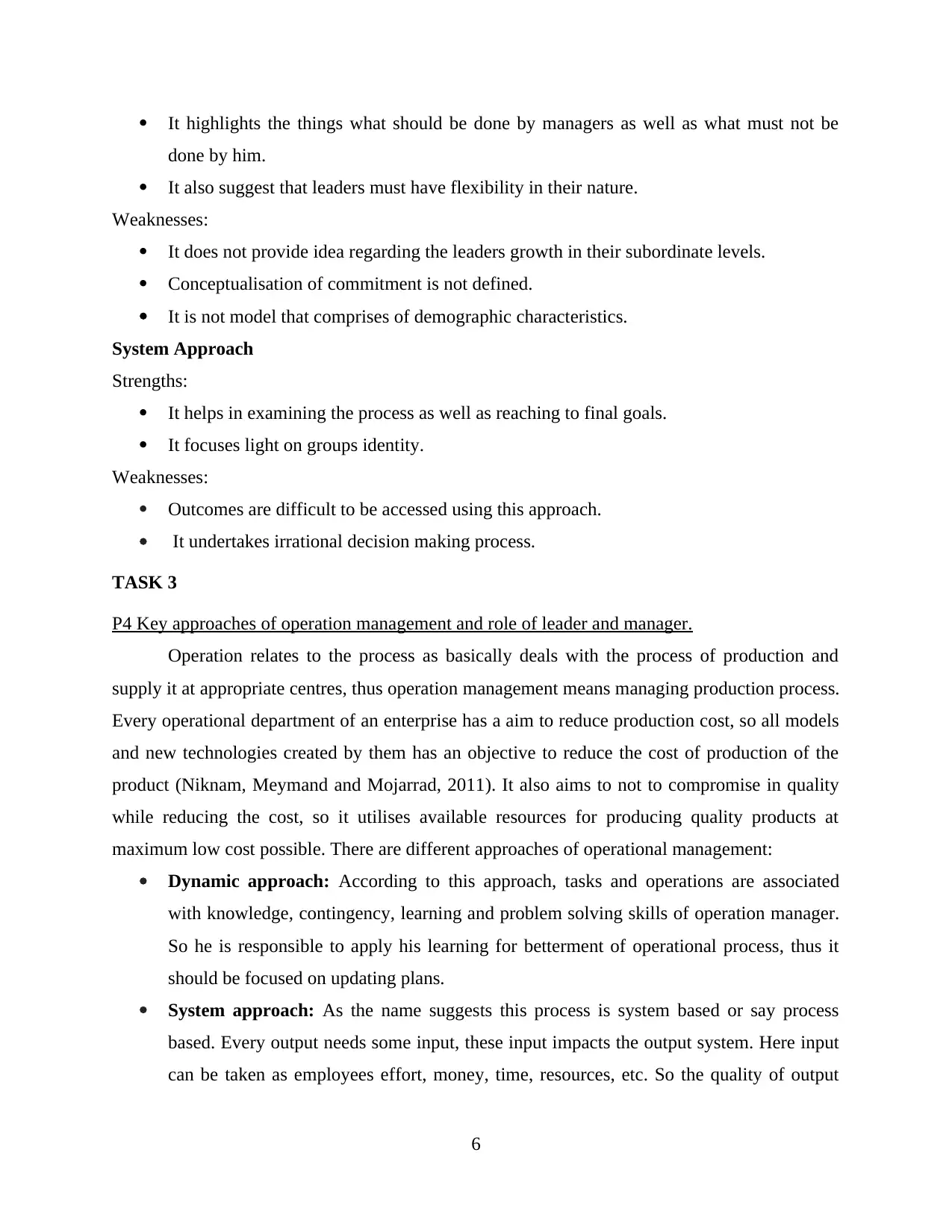
It highlights the things what should be done by managers as well as what must not be
done by him.
It also suggest that leaders must have flexibility in their nature.
Weaknesses:
It does not provide idea regarding the leaders growth in their subordinate levels.
Conceptualisation of commitment is not defined.
It is not model that comprises of demographic characteristics.
System Approach
Strengths:
It helps in examining the process as well as reaching to final goals.
It focuses light on groups identity.
Weaknesses:
Outcomes are difficult to be accessed using this approach.
It undertakes irrational decision making process.
TASK 3
P4 Key approaches of operation management and role of leader and manager.
Operation relates to the process as basically deals with the process of production and
supply it at appropriate centres, thus operation management means managing production process.
Every operational department of an enterprise has a aim to reduce production cost, so all models
and new technologies created by them has an objective to reduce the cost of production of the
product (Niknam, Meymand and Mojarrad, 2011). It also aims to not to compromise in quality
while reducing the cost, so it utilises available resources for producing quality products at
maximum low cost possible. There are different approaches of operational management:
Dynamic approach: According to this approach, tasks and operations are associated
with knowledge, contingency, learning and problem solving skills of operation manager.
So he is responsible to apply his learning for betterment of operational process, thus it
should be focused on updating plans.
System approach: As the name suggests this process is system based or say process
based. Every output needs some input, these input impacts the output system. Here input
can be taken as employees effort, money, time, resources, etc. So the quality of output
6
done by him.
It also suggest that leaders must have flexibility in their nature.
Weaknesses:
It does not provide idea regarding the leaders growth in their subordinate levels.
Conceptualisation of commitment is not defined.
It is not model that comprises of demographic characteristics.
System Approach
Strengths:
It helps in examining the process as well as reaching to final goals.
It focuses light on groups identity.
Weaknesses:
Outcomes are difficult to be accessed using this approach.
It undertakes irrational decision making process.
TASK 3
P4 Key approaches of operation management and role of leader and manager.
Operation relates to the process as basically deals with the process of production and
supply it at appropriate centres, thus operation management means managing production process.
Every operational department of an enterprise has a aim to reduce production cost, so all models
and new technologies created by them has an objective to reduce the cost of production of the
product (Niknam, Meymand and Mojarrad, 2011). It also aims to not to compromise in quality
while reducing the cost, so it utilises available resources for producing quality products at
maximum low cost possible. There are different approaches of operational management:
Dynamic approach: According to this approach, tasks and operations are associated
with knowledge, contingency, learning and problem solving skills of operation manager.
So he is responsible to apply his learning for betterment of operational process, thus it
should be focused on updating plans.
System approach: As the name suggests this process is system based or say process
based. Every output needs some input, these input impacts the output system. Here input
can be taken as employees effort, money, time, resources, etc. So the quality of output
6
⊘ This is a preview!⊘
Do you want full access?
Subscribe today to unlock all pages.

Trusted by 1+ million students worldwide
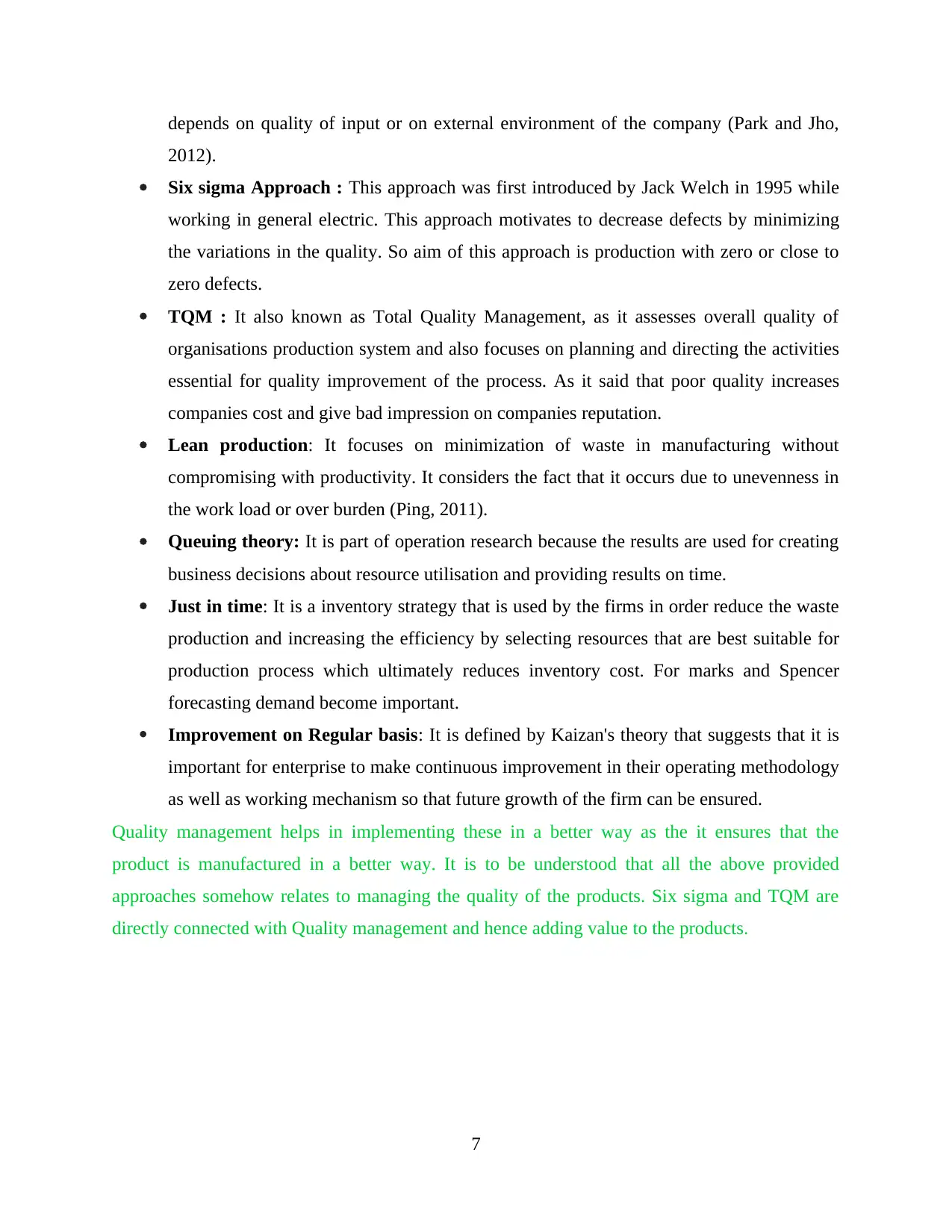
depends on quality of input or on external environment of the company (Park and Jho,
2012).
Six sigma Approach : This approach was first introduced by Jack Welch in 1995 while
working in general electric. This approach motivates to decrease defects by minimizing
the variations in the quality. So aim of this approach is production with zero or close to
zero defects.
TQM : It also known as Total Quality Management, as it assesses overall quality of
organisations production system and also focuses on planning and directing the activities
essential for quality improvement of the process. As it said that poor quality increases
companies cost and give bad impression on companies reputation.
Lean production: It focuses on minimization of waste in manufacturing without
compromising with productivity. It considers the fact that it occurs due to unevenness in
the work load or over burden (Ping, 2011).
Queuing theory: It is part of operation research because the results are used for creating
business decisions about resource utilisation and providing results on time.
Just in time: It is a inventory strategy that is used by the firms in order reduce the waste
production and increasing the efficiency by selecting resources that are best suitable for
production process which ultimately reduces inventory cost. For marks and Spencer
forecasting demand become important.
Improvement on Regular basis: It is defined by Kaizan's theory that suggests that it is
important for enterprise to make continuous improvement in their operating methodology
as well as working mechanism so that future growth of the firm can be ensured.
Quality management helps in implementing these in a better way as the it ensures that the
product is manufactured in a better way. It is to be understood that all the above provided
approaches somehow relates to managing the quality of the products. Six sigma and TQM are
directly connected with Quality management and hence adding value to the products.
7
2012).
Six sigma Approach : This approach was first introduced by Jack Welch in 1995 while
working in general electric. This approach motivates to decrease defects by minimizing
the variations in the quality. So aim of this approach is production with zero or close to
zero defects.
TQM : It also known as Total Quality Management, as it assesses overall quality of
organisations production system and also focuses on planning and directing the activities
essential for quality improvement of the process. As it said that poor quality increases
companies cost and give bad impression on companies reputation.
Lean production: It focuses on minimization of waste in manufacturing without
compromising with productivity. It considers the fact that it occurs due to unevenness in
the work load or over burden (Ping, 2011).
Queuing theory: It is part of operation research because the results are used for creating
business decisions about resource utilisation and providing results on time.
Just in time: It is a inventory strategy that is used by the firms in order reduce the waste
production and increasing the efficiency by selecting resources that are best suitable for
production process which ultimately reduces inventory cost. For marks and Spencer
forecasting demand become important.
Improvement on Regular basis: It is defined by Kaizan's theory that suggests that it is
important for enterprise to make continuous improvement in their operating methodology
as well as working mechanism so that future growth of the firm can be ensured.
Quality management helps in implementing these in a better way as the it ensures that the
product is manufactured in a better way. It is to be understood that all the above provided
approaches somehow relates to managing the quality of the products. Six sigma and TQM are
directly connected with Quality management and hence adding value to the products.
7
Paraphrase This Document
Need a fresh take? Get an instant paraphrase of this document with our AI Paraphraser
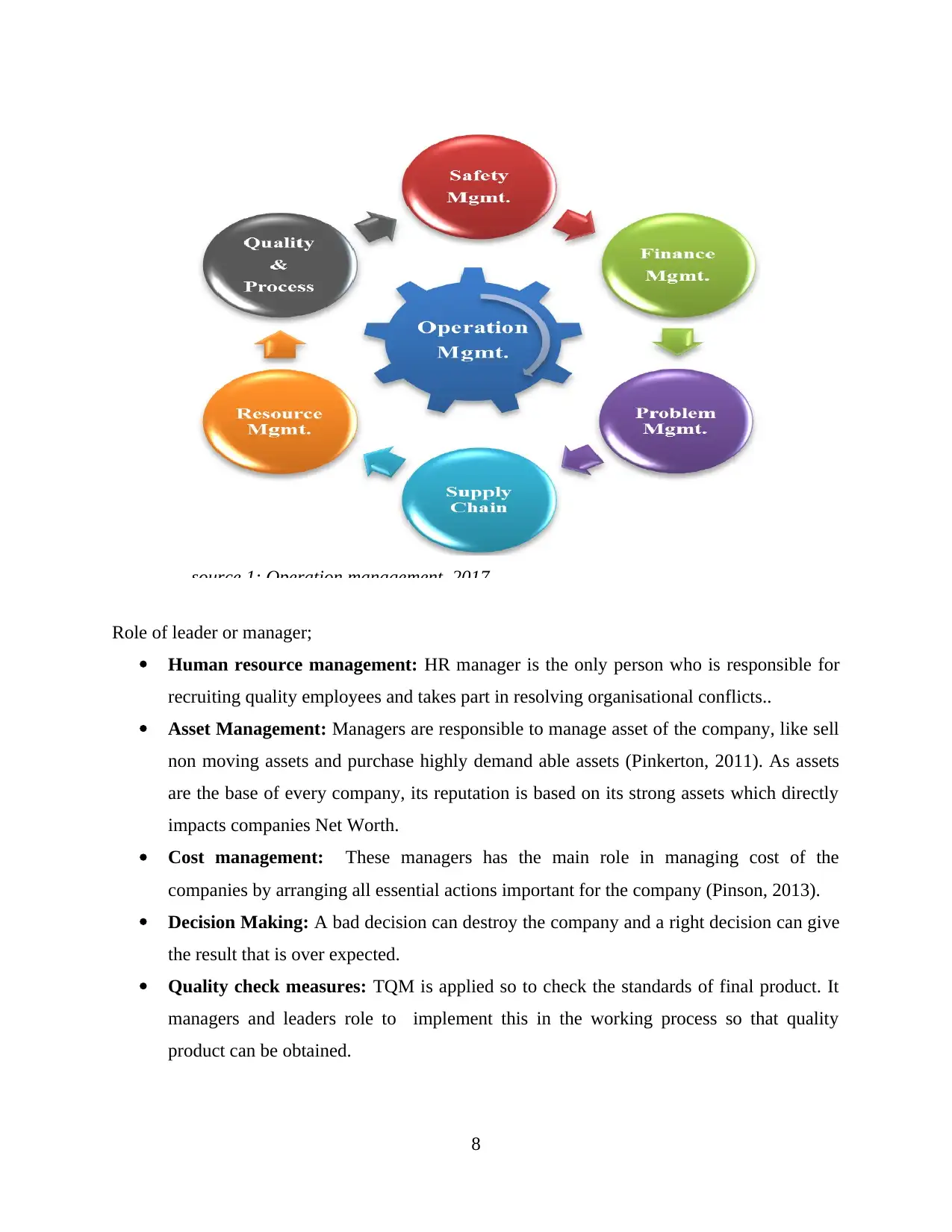
Role of leader or manager;
Human resource management: HR manager is the only person who is responsible for
recruiting quality employees and takes part in resolving organisational conflicts..
Asset Management: Managers are responsible to manage asset of the company, like sell
non moving assets and purchase highly demand able assets (Pinkerton, 2011). As assets
are the base of every company, its reputation is based on its strong assets which directly
impacts companies Net Worth.
Cost management: These managers has the main role in managing cost of the
companies by arranging all essential actions important for the company (Pinson, 2013).
Decision Making: A bad decision can destroy the company and a right decision can give
the result that is over expected.
Quality check measures: TQM is applied so to check the standards of final product. It
managers and leaders role to implement this in the working process so that quality
product can be obtained.
8
source 1: Operation management, 2017
Human resource management: HR manager is the only person who is responsible for
recruiting quality employees and takes part in resolving organisational conflicts..
Asset Management: Managers are responsible to manage asset of the company, like sell
non moving assets and purchase highly demand able assets (Pinkerton, 2011). As assets
are the base of every company, its reputation is based on its strong assets which directly
impacts companies Net Worth.
Cost management: These managers has the main role in managing cost of the
companies by arranging all essential actions important for the company (Pinson, 2013).
Decision Making: A bad decision can destroy the company and a right decision can give
the result that is over expected.
Quality check measures: TQM is applied so to check the standards of final product. It
managers and leaders role to implement this in the working process so that quality
product can be obtained.
8
source 1: Operation management, 2017
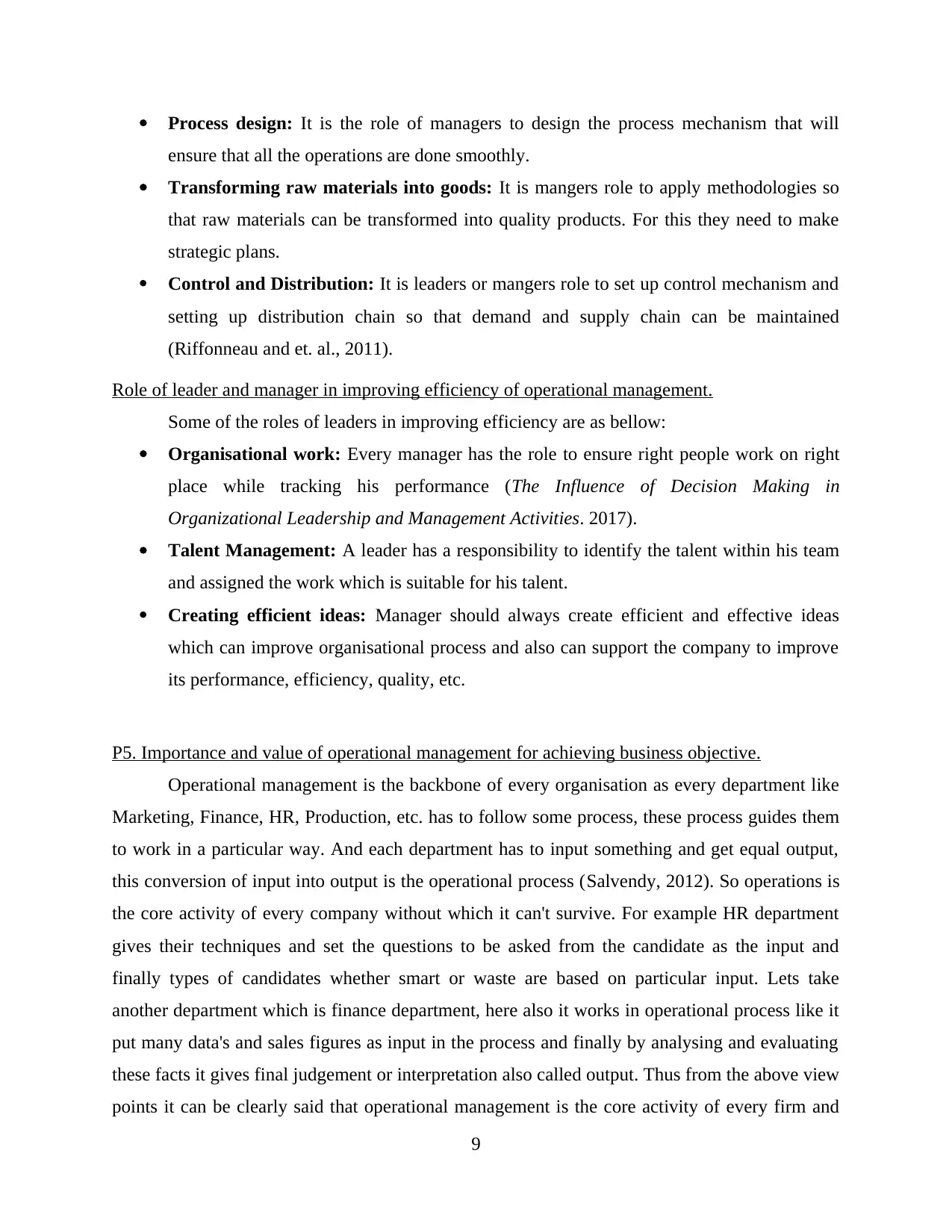
Process design: It is the role of managers to design the process mechanism that will
ensure that all the operations are done smoothly.
Transforming raw materials into goods: It is mangers role to apply methodologies so
that raw materials can be transformed into quality products. For this they need to make
strategic plans.
Control and Distribution: It is leaders or mangers role to set up control mechanism and
setting up distribution chain so that demand and supply chain can be maintained
(Riffonneau and et. al., 2011).
Role of leader and manager in improving efficiency of operational management.
Some of the roles of leaders in improving efficiency are as bellow:
Organisational work: Every manager has the role to ensure right people work on right
place while tracking his performance (The Influence of Decision Making in
Organizational Leadership and Management Activities. 2017).
Talent Management: A leader has a responsibility to identify the talent within his team
and assigned the work which is suitable for his talent.
Creating efficient ideas: Manager should always create efficient and effective ideas
which can improve organisational process and also can support the company to improve
its performance, efficiency, quality, etc.
P5. Importance and value of operational management for achieving business objective.
Operational management is the backbone of every organisation as every department like
Marketing, Finance, HR, Production, etc. has to follow some process, these process guides them
to work in a particular way. And each department has to input something and get equal output,
this conversion of input into output is the operational process (Salvendy, 2012). So operations is
the core activity of every company without which it can't survive. For example HR department
gives their techniques and set the questions to be asked from the candidate as the input and
finally types of candidates whether smart or waste are based on particular input. Lets take
another department which is finance department, here also it works in operational process like it
put many data's and sales figures as input in the process and finally by analysing and evaluating
these facts it gives final judgement or interpretation also called output. Thus from the above view
points it can be clearly said that operational management is the core activity of every firm and
9
ensure that all the operations are done smoothly.
Transforming raw materials into goods: It is mangers role to apply methodologies so
that raw materials can be transformed into quality products. For this they need to make
strategic plans.
Control and Distribution: It is leaders or mangers role to set up control mechanism and
setting up distribution chain so that demand and supply chain can be maintained
(Riffonneau and et. al., 2011).
Role of leader and manager in improving efficiency of operational management.
Some of the roles of leaders in improving efficiency are as bellow:
Organisational work: Every manager has the role to ensure right people work on right
place while tracking his performance (The Influence of Decision Making in
Organizational Leadership and Management Activities. 2017).
Talent Management: A leader has a responsibility to identify the talent within his team
and assigned the work which is suitable for his talent.
Creating efficient ideas: Manager should always create efficient and effective ideas
which can improve organisational process and also can support the company to improve
its performance, efficiency, quality, etc.
P5. Importance and value of operational management for achieving business objective.
Operational management is the backbone of every organisation as every department like
Marketing, Finance, HR, Production, etc. has to follow some process, these process guides them
to work in a particular way. And each department has to input something and get equal output,
this conversion of input into output is the operational process (Salvendy, 2012). So operations is
the core activity of every company without which it can't survive. For example HR department
gives their techniques and set the questions to be asked from the candidate as the input and
finally types of candidates whether smart or waste are based on particular input. Lets take
another department which is finance department, here also it works in operational process like it
put many data's and sales figures as input in the process and finally by analysing and evaluating
these facts it gives final judgement or interpretation also called output. Thus from the above view
points it can be clearly said that operational management is the core activity of every firm and
9
⊘ This is a preview!⊘
Do you want full access?
Subscribe today to unlock all pages.

Trusted by 1+ million students worldwide
1 out of 16
Related Documents
Your All-in-One AI-Powered Toolkit for Academic Success.
+13062052269
info@desklib.com
Available 24*7 on WhatsApp / Email
![[object Object]](/_next/static/media/star-bottom.7253800d.svg)
Unlock your academic potential
Copyright © 2020–2025 A2Z Services. All Rights Reserved. Developed and managed by ZUCOL.





